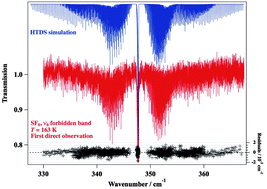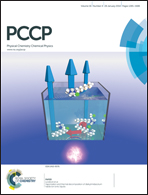Resolving the forbidden band of SF6
Abstract
Sulfur hexafluoride is an important molecule for modeling thermophysical and polarizability properties. It is also a potent greenhouse gas of anthropogenic origin, whose concentration in the atmosphere, although very low is increasing rapidly; its global warming power is mostly conferred by its strong infrared absorption in the ν3 S–F stretching region near 948 cm−1. This heavy species, however, features many hot bands at room temperature (at which only 31% of the molecules lie in the ground vibrational state), especially those originating from the lowest, v6 = 1 vibrational state. Unfortunately, the ν6 band itself (near 347 cm−1), in the first approximation, is both infrared- and Raman-inactive, and no reliable spectroscopic information could be obtained up to now and this has precluded a correct modeling of the hot bands. It has been suggested theoretically and experimentally that this band might be slightly activated through Coriolis interaction with infrared-active fundamentals and appears in high pressure measurements as a very faint, unresolved band. Using a new cryogenic multipass cell with 93 m optical path length and regulated at 163 ± 2 K temperature, coupled to synchrotron radiation and a high resolution interferometer, the spectrum of the ν6 far-infrared region has been recorded. Low temperature was used to avoid the presence of hot bands. We are thus able to confirm that the small feature in this region, previously viewed at low-resolution, is indeed ν6. The fully resolved spectrum has been analyzed, thanks to the XTDS software package. The band appears to be activated by faint Coriolis interactions with the strong ν3 and ν4 fundamental bands, resulting in the appearance of a small first-order dipole moment term, inducing unusual selection rules. The band center (ν6 = 347.736707(35) cm−1) and rovibrational parameters are now accurately determined for the v6 = 1 level. The ν6 perturbation-induced dipole moment is estimated to be 33 ± 3 μD and the ν6 integrated intensity to be 0.0035 km mol−1.


 Please wait while we load your content...
Please wait while we load your content...